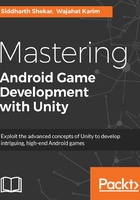
Unity3D
Unity (http://unity3d.com) is cross-platform game engine developed by Unity Technologies. It made its first public announcement at Apple's Worldwide Developers Conference in 2005 and supported only game development for Mac OS, but since then it has been extended to target more than 15 platforms for desktop, mobile, and consoles. It is notable for its one-click ability to port games on multiple platforms, including BlackBerry 10, Windows Phone 10, Windows 10, OS X, Linux, Android, iOS, Unity Web Player (including Facebook), Adobe Flash, PlayStation 3, PlayStation 4, PlayStation Vita, Xbox 360, Xbox One, Wii U, and Wii.
Unity has a fantastic interface that lets the developers manage the project really efficiently from the get-go. It has nice drag-drop functionality with connecting behavior scripts written in C# and Boo (a dialect of JavaScript) to define the custom logic and functionality with visual objects quite easily. Unity has been proven quite easy to learn for the new developers who are just starting out with game development and now more large studios have also started it using, and that is also for good reasons.
Unity is one of those engines that provides support for both 2D and 3D games without putting developers in trouble and confusion. It has vast collection of online tutorials, great documentation, and a very helpful community of developers. Also, Unity has the Asset Store, where developers sell reusable components of Unity to reduce the development time and efforts for other developers. You can check Unity Asset Store at http://assetstore.unity3d.com.
Unity Plus and Pro are available for a fee, and Unity Personal has no fee; it is available any use to individuals or companies with less than US $100,000 of annual gross revenue. For more information, visit the Unity store at https://store.unity.com/:
